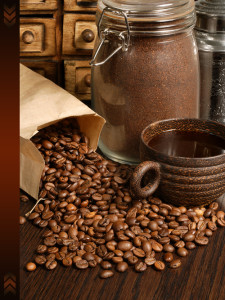Coffee-Grinding Tips and Facts

The debate over whole beans versus ground beans will probably never be resolved; there are some tips and facts about various kinds of grinds and the best use of each. And there are some pros and cons to using whole beans and using ground coffee.
So here are some coffee-grinding tips and facts.
1. Whole Beans – Pros and Cons
Whole coffee beans hold their flavor longer because the essential oils within the bean are not exposed to air. Grinding it yourself for each cup or pot results in a fresher, more flavorful cup of coffee. Whole beans also have a much longer shelf life, about ten times longer than pre-ground coffee, possibly making whole beans more economical.
Another advantage of whole beans is that you can choose the coarseness of the grind yourself, depending on the results you’re aiming for. You will have to purchase a coffee grinder, though, and it will increase your preparation time.
2. Ground Coffee – Pros and Cons
As soon as coffee beans are ground, their essential oils (where the flavor and aroma are) become airborne. (That’s why it smells so good!) So naturally, those essential oils floating around in the air are not making it into your cup. Consequently, pre-ground coffee tends to be less fresh and flavorful. If you tend to consume coffee quickly, however, pre-ground may work for you – sources say you have about nine days for ground coffee to retain its freshness after it’s opened. And of course, pre-ground coffee is faster to make and more convenient.
3. Grinding Coffee
How you grind your coffee makes a difference in how it tastes. Here are some tips to consider:
* How finely you grind your coffee determines its strength – finely-ground beans will yield a more concentrated, stronger flavor. (Espresso is made with very finely ground beans.)
* Coarse grinds work best for a press-style pot or French press.
* A medium grind works for the typical drip coffee maker, but within the medium grind range, there are subtle differences that depend on the kind of filter you use.
* Fine grinds do well with espresso machines, and can often be used in drip makers too.
* Extra fine is solely for espresso, as are super-fine grinds. Super-fine can also be used in a Turkish coffee maker.
4. Alternative Brewing
There are some interesting ways that coffee is brewed in various cultures and parts of the world. In Indonesia, coffee is brewed a bit like tea – hot water is poured over the grounds in the cup, and the coffee grounds slowly settle to the bottom while the coffee steeps and cools. If you use a very fine grind for this method, you’ll end up with what is known in the Middle East as “mud coffee.”
In Nordic countries and some Middle Eastern countries, coffee is sometimes boiled. This results in a more bitter brew.
Whether you buy whole beans or pre-ground, coffee is a more versatile beverage than you may have realized!








You must be logged in to post a comment.